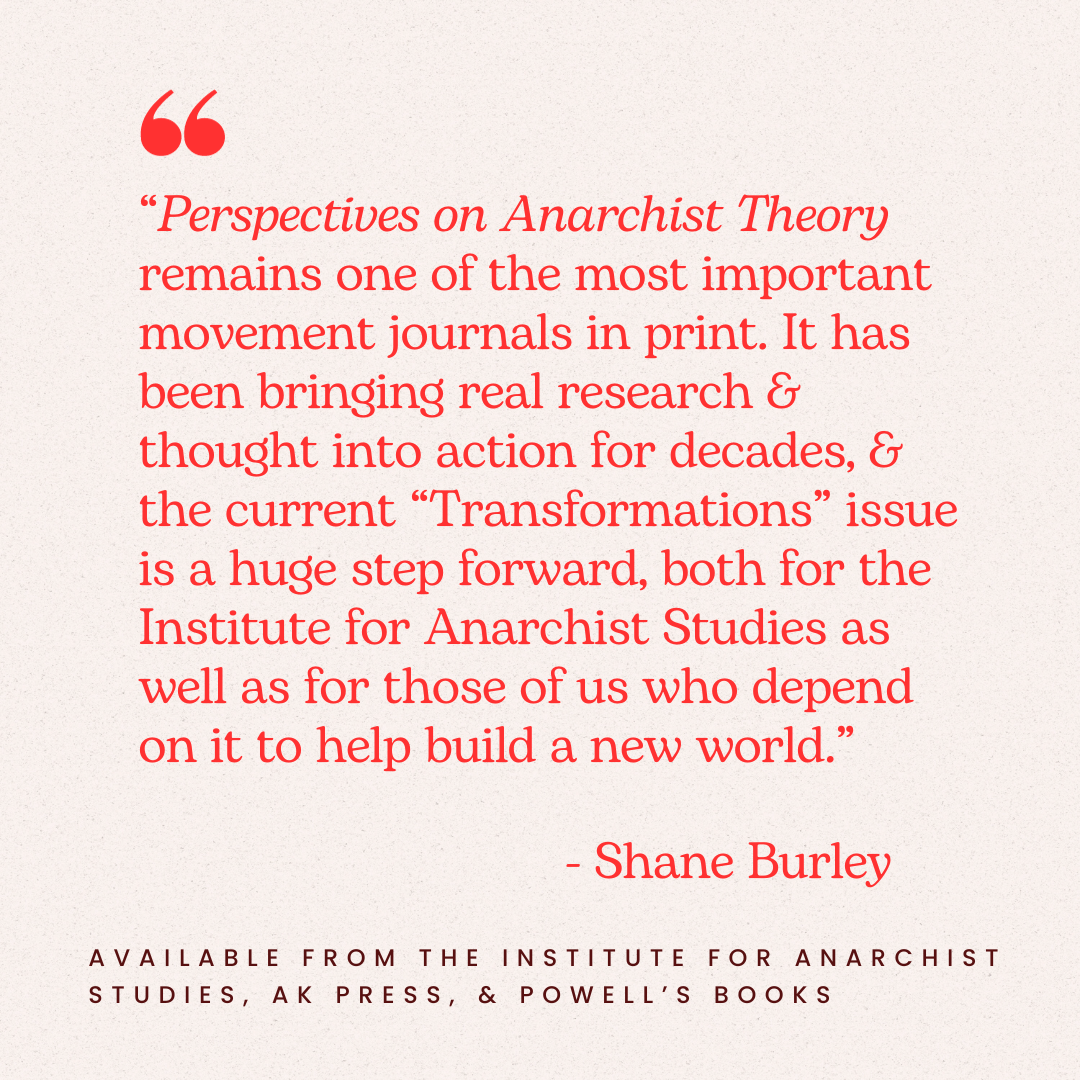Get a copy of the current Transformations issue of Perspectives on Anarchist Theory by clicking here!
What’s in this issue you ask?
TABLE OF CONTENTS: PERSPECTIVES ON ANARCHIST THEORY, n33, 2023
Introduction: Transformations by Lara Messersmith-Glavin, in which she weaves together themes of tarot and change, asking “Whose memories form the collective subconscious from which we draw meaning? Whose dreams are hidden within the imagery of our archetypes? What histories are told in the words we use, the lines we observe, the many ways we inhabit our bodies?”
Demodernizing Anarchism by Jesse Cohn
Cohn uses Carlos Taibo’s recent book Anarquistas de Ultramar as a springboard into some thoughts about anarchism’s entanglement with modernity as a barrier to alliances with Indigenous peoples’ movements. In particular, he explores definitions of modernity and indigeneity; distinctions between “nonmodernity”, postmodernism, anti-modernism, primitivism, anti-civ; and considers proposals for revisions to anarchist theory. And, ultimately, Cohn suggests that rethinking modernity can help anarchists working from the European tradition to form better mutual understandings with Indigenous militants.
Single Mother, a poem by Emily Schwartig, meditating on single motherhood, poverty, stigma, and shame.
How to Tan a Hide, by Mattie Ecklund
This piece is a braided essay that pulls together strands of a young woman’s experiences trying to learn and recapture ancestral practices of hide-tanning, along with a memoir of working as a cook for super-wealthy employers, and finally incorporating feminist and anticolonialist critiques of labor.
Place as Message: Anarchist Climate Change Communication through Performance by Taiga Christie
This piece explores new ways to communicate experiences of the climate crisis in its telling of a new live performance by Faultline Ensemble. The performance brings together stories of climate scientist mental health, nuclear waste storage labeling, covid-19 education and the voyager Golden Record to explore experiences of burnout, occupational stress, communication strife and interpersonal relationships in a pandemic world. In so doing, the Ensemble builds spaces to imagine new ways of building community resilience to climate change, humanizes emotional reactions to climate change, and advocates for person-centered approaches to climate activism.

Love & Rage: The Eros Effect and Spontaneous Combustion by Paul Messersmith-Glavin and Hillary Lazar
An essay contextualizing George Katsiaficas’ response to AK Thompson’s Spontaneous Combustion, as part of their debate over the role of political eros or “revolutionary love” in motivating collective action. To this end, the piece provides a biographical narrative of Katsiaficas’ life and work, including his intellectual and political grounding in Marcusian thought and his theory of the “eros effect” for understanding moments of global protest. In addition to the background on Katsiaficas, the piece also reflects on the authors’ perspectives on the importance of both love and rage in movements.
A Response to Spontaneous Combustion by George Katsiaficas
Katsiaficas’ response to AK Thomspon’s work and edited collection of essays, Spontaneous Combustion, in which Thompson and others challenge and expand upon Katsiaficas’ eros effect–his position that our innate need for human connection is what drives global moments of rebellion. In this response, Katsiaficas provides context for his development of the eros effect, responds to many of the critiques and questions raised in the edited collection, and in particular addresses Thompson’s position that rather than eros or love it is instead “biological hatred” or “lack” that catalyze collective action.
Silence in Perpetual Noise by Alayne Ballentine
This piece is written from the perspective of a formerly incarcerated woman and asks hard questions about the ways in which the emotional and physical traumas of the prison system self-replicate in the social engagement of the prisoners themselves.
Consensus Decision-Making in Christiania by Tauno Biltsted
This piece is a write-up of the author’s visit to Christiania, highlighting some of the elements that go into the city’s consensus-based decision-making processes and practices.
Anarchist Cybernetics by Thomas Swann
This piece explores how cybernetics can provide a framework for understanding how people can organize their lives collectively and without structural hierarchies of command. Appelaing to Colin Ward’s 1966 essay on the subject, Swann argues that at the center of the connection between anarchism and cybernetics is the idea of self-organization, which was initially developed in the context of technical systems, but can be applied to social systems as well.
This is How We Heal by Susan Anglada Bartley and Lexi Khan
A collaboratively written article by Susan Anglada Bartley and Lexy Kahn, resulting from their conversations after participating in the 2020 Black Lives Matter uprising and ongoing anti-fascist efforts in Portland both as frontline protestors and as movement-side writers and journalists. Throughout the article they offer two perspectives on healing and resistance, along with recounting major moments from the protests in the summer of 2020 and providing important local activist history.
Living Communism: Theory and Practice of Autonomy and Attack by Spencer Beswick
Drawing on historical insights from the West German Autonomen with theoretical interventions from the Invisible Committee, Bewsick offers several related arguments about the theory and practice of communes: 1) communes create alternative worlds that challenge liberalism and alienation; 2) communes operate according to a unique spatial logic that ruptures capitalist geography and alienation; 3) the Autonomen and the Invisible Committee promote a new conception of communism as a collective practice of living the “good life” in revolutionary struggle; 4) alternative infrastructure provides the means to practice this everyday lived communism; and 5) networked communes serve as the basis of revolutionary insurrectionary practice.
Organizing Disruption. Review of After the Revolution and Begin the World Over by Dylan Clymer
Clymer explores how literature created from the anarchist imagination is an exploration of praxis Furthermore, in examining the power of the anarchist imagination paired with literature, theory, and contemporary events, he reflects on how art and anarchist literary perspectives are important tools we can use to disrupt the powerful flows of propaganda and disinformation being used to advance fascist agendas. Clymer does this through a review of AK Press publications Begin the World Over and After the Revolution.
Who’s Processing Whom? Digital Commons, Digital Blinders, and a Fraught Social Future by Chris Carlsson
This piece is about Carlsson’s personal experiences at the dawn of the digital age, including his work with the journal, Processed World. The second half of the piece serves as a literature review of different theorists engaging with questions around how global capital is using internet culture and algorithmic structures to direct consumer experiences and curate political thought.
This issue features the Abolitionist Tarot of Kai Lumumba Barrow!

Get a copy by clicking here!

